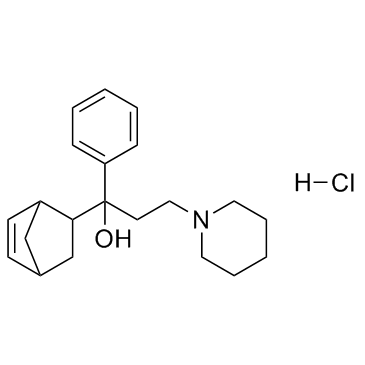1235-82-1
| Name | biperiden hydrochloride |
|---|---|
| Synonyms |
1-(5-bicyclo[2.2.1]hept-2-enyl)-1-phenyl-3-piperidin-1-ylpropan-1-ol,hydrochloride
1-Piperidinepropanol, α-bicyclo[2.2.1]hept-5-en-2-yl-α-phenyl-, hydrochloride (1:1) 1-(Bicyclo[2.2.1]hept-5-en-2-yl)-1-phenyl-3-(piperidin-1-yl)propan-1-ol hydrochloride (1:1) 1-bicyclo[2.2.1]hept-5-en-2-yl-1-phenyl-3-piperidin-1-ylpropan-1-ol hydrochloride a-5-Norbornen-2-yl-a-phenyl-1-piperidinepropanol Hydrochloride EINECS 214-976-2 1-(Bicyclo[2.2.1]hept-5-en-2-yl)-1-phenyl-3-(1-piperidinyl)-1-propanol hydrochloride (1:1) 1-Bicyclo[2.2.1]hept-5-en-2-yl-1-phenyl-3-piperidin-1-ylpropan-1-olhydrochlorid Biperiden Hydrochloride 1-Bicycloheptenyl-1-phenyl-3-piperidinopropanol Hydrochloride a-Bicyclo[2.2.1]hept-5-en-2-yl-a-phenyl-1-piperidinepropanol hydrochloride 1-piperidinepropanol, α-bicyclo[2.2.1]hept-5-en-2-yl-α-phenyl-, hydrochloride 1-bicyclo[2.2.1]hept-5-én-2-yl-1-phényl-3-pipéridin-1-ylpropan-1-ol chlorhydrate Biperidene hydrochloride biperidine hydrochloride Biperiden (Hydrochloride) |
| Description | Biperiden(KL 373) Hcl is an antiparkinsonian agent, which is the selective central M1 cholinoreceptors blocker.Target: M1 receptorsBiperiden is an antiparkinsonian agent of the anticholinergic type. It is used for the adjunctive treatment of all forms of Parkinson's disease (postencephalitic, idiopathic, and arteriosclerotic)[1]. Biperiden has an atropine-like blocking effect on all peripheral structures which are parasympathetic-innervate. It also has a prominent central blocking effect on M1 receptors [2].Biperiden (0.11 mg/kg), benactyzine (0.3 mg/kg),caramiphen (10 mg/kg), procyclidine (3 mg/kg), and trihexyphenidyl (0.12 mg/kg) separately and each in combination with physostigmine (0.1 mg/kg) is to make a comparative assessment of potential cognitive effects. The results showed that benactyzine, caramiphen, and trihexyphenidyl reduced rats' innate preference for novelty, whereas biperiden and procyclidine did not [3].Clinical indications: parkinsonismFDA Approved Date: Toxicity: Drowsiness; vertigo; headache; dizziness |
|---|---|
| Related Catalog | |
| References |
| Boiling Point | 462.1ºC at 760 mmHg |
|---|---|
| Melting Point | 101ºC |
| Molecular Formula | C21H30ClNO |
| Molecular Weight | 347.922 |
| Flash Point | 224.5ºC |
| Exact Mass | 347.201599 |
| PSA | 23.47000 |
| LogP | 4.70230 |
| Vapour Pressure | 2.45E-09mmHg at 25°C |
| Water Solubility | DMSO: >20mg/mL |
CHEMICAL IDENTIFICATION
HEALTH HAZARD DATAACUTE TOXICITY DATA
|
| Symbol |

GHS07 |
|---|---|
| Signal Word | Warning |
| Hazard Statements | H302-H319 |
| Precautionary Statements | P301 + P312 + P330-P305 + P351 + P338 |
| Personal Protective Equipment | dust mask type N95 (US);Eyeshields;Gloves |
| Hazard Codes | Xn: Harmful; |
| Risk Phrases | R22 |
| RIDADR | NONH for all modes of transport |
| RTECS | TN3706000 |
